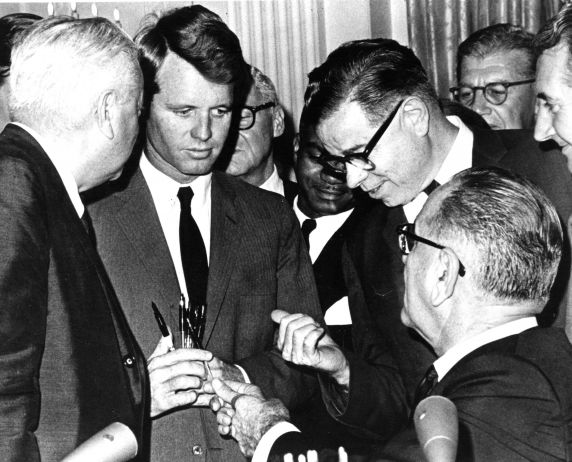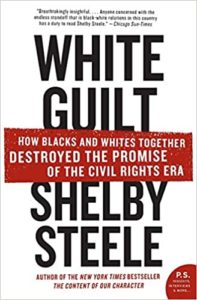Black Power Gained, Black Agency Sacrificed
By Arnold Kling


- If you were black, and thus a victim of racial oppression, this new morality of social justice meant you could not be expected to carry the same responsibility as others. The point was that the American society no longer had the moral authority to enforce a single standard of responsibility for everyone because—by its own admission—it had not treated everyone the same.
- … now I was the one—as a victim—who possessed an almost reckless moral authority. Now I could shame and silence whites at will. With this moral authority there was the power to better defend myself against racism, but there was also a new, abusive power very similar to the abusive power that had been wielded against me—a power of racial privilege deriving solely from the color of my skin.
- Shelby Steele, White Guilt: How Blacks and Whites Together Destroyed the Promise of the Civil Rights Era.1
In 2020, race relations in the United States became particularly tense and roiled. Protests erupted whenever a young African American died at the hands of police. Many progressive whites became fervent supporters of the Black Lives Matter movement. On college campuses, new protest movements sprang up, making demands on institutions accused of racism.2 Critical Race Theory, which re-interprets norms such as the scientific method and freedom of speech as tools of white oppression, spread out of its academic strongholds into American institutional life as a whole.3 Schools, corporations, and other organizations hastened to institutionalize and bolster “diversity and inclusion” training, even as President Trump signed an executive order that attempted to ban the use of Critical Race Theory in government training programs.4 (This order was rescinded by President Biden on his first day in office.)
Shelby Steele, writing in 2006, offered a theory to explain how racial dynamics evolved in the wake of the Civil Rights era.
- White guilt: the vacuum of moral authority that comes from simply knowing that one’s race is associated with racism. Whites (and American institutions) must acknowledge historical racism to show themselves redeemed of it, but once they acknowledge it, they lose moral authority over everything having to do with race equality, social justice, poverty, and so on… The authority they lose transfers to the “victims” of historical racism and becomes their great power in society.
In the United States, whites abused blacks for many decades. Legally, this abuse ended with the Civil Rights legislation of 1964 and 1965. But those acts did not erase the sordid history. Steele’s thesis is that sensitivity to this history produces white guilt and fuels black anger. The result is that blacks have become the abusers, and whites—liberal whites, especially—have become the abused.
Steele’s analysis is based on introspection regarding his own experience. Born in 1946, he grew up in Chicago in the era of segregation. While segregation carried the force of law in the South, in the North it was enforced by social norms. Steele tells a poignant story that as a youngster he insinuated himself into a position as batboy for a white YMCA baseball team, only to be told that he could not accompany the team to any games, because they were going to play in white neighborhoods.
The Saint Louis area had the same sort of segregation when I was growing up. There were certain communities where no whites lived because they wouldn’t. And there were other communities where no blacks lived because they couldn’t. Mortgage lenders and real estate agents enforced this segregation. In my neighborhood, the first black families did not appear until 1965 (as it happened, my family had moved by then). The Fair Housing Act which prohibited racial discrimination in housing was the last piece of major Civil Rights legislation, and it was only passed in 1968, finally achieved in the wake of the outpouring of emotion following the assassination of Dr. Martin Luther King, Jr.
The Civil Rights laws changed the central focus of the racial justice movement. Before 1964, the goal was achieving institutional change to end discrimination. Subsequently, the emphasis shifted to remediating the effects of past discrimination.
Steele sees the focus on past discrimination as fostering a dynamic between white guilt and black anger. For example, on college campuses a group of black students would confront liberal white administrators with a list of demands. Even if the demands were unreasonable and the students employed coercion, the administrators felt too guilty to resist. This tended to reinforce and reward black anger, rather than appease it.
Steele himself was one of those black student militants. He led a group of demonstrators into the office of his college President. He emphasizes his memory of deliberately allowing his cigarette ashes to fall on the plush carpet as illustrating the ability and desire to abuse that gentleman.
He argues that anger can be inversely related to the level of injustice.
- Anger is acted out by the oppressed only when real weakness is perceived in the oppressor. So anger is never automatic or even inevitable for the oppressed; it is chosen when weakness in the oppressor means it will be effective in winning freedom or justice or spoils of some kind. Anger in the oppressed is a response to perceived opportunity, not to injustice. And expressions of anger escalate not with more injustice but with less injustice.
This black anger was enabled by and reinforced white guilt.
- In fact, if there is a white racial identity today it would have to be white guilt—a shared, even unifying, lack of racial moral authority. As other group identities derived from a shared fate, white guilt is a shared white fate rendered up by history. Whites can no more escape white guilt than blacks can reject being black.
Steele sees this interaction between black anger and white guilt as driving race relations since the late 1960s. His thesis seems pertinent today. Steele’s son, Eli, recently wrote,
- The battle over how to move forward was roughly divided into two camps: those who believed in individual development as the best way to improve the lives of blacks, and those who believed that racial preferences and quotas could be used to re-engineer our society. I chose the path of individual development. My grandparents and my father had grown up under the unrelenting accusation that they were inferior people so why would I perpetuate that stigma by demanding special dispensations on account of my race that were denied to my fellow citizens on account of theirs? I also chose the path of development because I believe that the stronger an individual is, the more he or she is an asset to society.
- Sadly, America’s institutional powers opted to take the path of racial engineering instead.5
Both Shelby and Eli Steele believe that the power that African Americans obtain from white guilt comes with a price. African Americans sacrificed agency. They attribute their life outcomes to external forces in general and to whites in particular.
Agency is a person’s subjective belief in one’s ability to affect one’s life. A person with agency feels responsible for what happens to them. The stronger one’s sense of agency, the happier a person is likely to be.
A person can be very well off materially and still feel oppressed and victimized by others. At the other extreme, a person can be incarcerated and yet work on self-improvement and planning for the future. Anwar Sadat and Malcolm X are two historical figures who felt that their experience in prison gave them insight and strength.
Before 1964, African Americans were very constrained in terms of power. But within those constraints, they could and did struggle to achieve on their own, individually and through political movements.
But by 1967, Shelby Steele writes,
- the goal of the civil rights movement had escalated from a simple demand for equal rights to a demand for the redistribution of responsibility for black advancement from black to white America, from the “victims” to the “guilty.” This marked a profound—and I believe tragic—turning point in the long struggle of black Americans for a better life.
The irony is that as the objective power of whites over blacks gave way to Civil Rights legislation, this was undercut by black leaders who sacrificed agency. They shifted the focus away from individual or collective achievement to extracting concessions from whites.
- By the mid-sixties white guilt was eliciting an entirely new kind of black leadership, not selfless men like King [Reverend Dr. Martin Luther King, Jr.] who appealed to the nation’s moral character but smaller men, bargainers, bluffers, and haranguers—not moralists but specialists in moral indignation—who could set up a trade with white guilt.
When he led his college protest, Steele might have continued on the path of becoming one of these “smaller men.” But gradually he came to hold a different point of view. He justifies this transformation in some powerful passages, with which I will conclude:
- By the mid-eighties the schizophrenia imposed on me as a black who was identified with the left had become unbearable. I had no interest in becoming a conservative. I just instinctively disliked the left’s disregard for principles that had always been important to me.
- … the left has effectively ceded its old territory—compassionate Jeffersonian liberalism—to the right, thereby ceding to it precisely the democratic principles and values of individual freedom and responsibility that have made America a great nation despite its many betrayals of these principles…
- In fact, most of today’s conservatives sound like Martin Luther King in 1963… Is there, on the right, a covert, unspoken loyalty to racial hierarchy, a quiet atavistic commitment to white supremacy? In the hearts of some there must be. There are fools and devils everywhere. But today’s right has made itself accountable to the democratic and moral vision of the early Martin Luther King.
Footnotes
[1] Shelby Steele, White Guilt: How Blacks and Whites Together Destroyed the Promise of the Civil Rights Era. HarperCollins, 2006.
[2] See, for example, “Faculty Members Propose an Anti-Racism Agenda.” Princeton Alumni Weekly, July 13, 2020.
[3] See, for example, “Smithsonian museum apologizes for saying hard work, rational thought is ‘white culture’,” by Chacour Koop. Miami Herald, July 17, 2020.
[4] See “President Issues Contractor ‘Critical Race Theory’ Executive Order,” by Eric Crusius. Holland and Knight Government Contracts Blog, September 23, 2020.
[5] Eli Steele, “The Battle for Moral Authority,” by Eli Steele. Quillette, January 23, 2021.
*Arnold Kling has a Ph.D. in economics from the Massachusetts Institute of Technology. He is the author of several books, including Crisis of Abundance: Rethinking How We Pay for Health Care; Invisible Wealth: The Hidden Story of How Markets Work; Unchecked and Unbalanced: How the Discrepancy Between Knowledge and Power Caused the Financial Crisis and Threatens Democracy; and Specialization and Trade: A Re-introduction to Economics. He contributed to EconLog from January 2003 through August 2012.
Read more of what Arnold Kling’s been reading. For more book reviews and articles by Arnold Kling, see the Archive.
